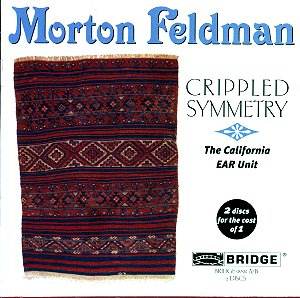|
|
Search MusicWeb Here |
|
 |
||
|
Founder:
Len Mullenger (1942-2025) Editor
in Chief:John Quinn
|
|
|
Search MusicWeb Here |
|
 |
||
|
Founder:
Len Mullenger (1942-2025) Editor
in Chief:John Quinn
|
 |
Morton FELDMAN (1923-1987)
Crippled Symmetry (1983) Recorded 1999 |
|
|
AVAILABILITY |
||
Feldman drew inspiration from a wide and rich diversity of sources, many of them visual, having earlier rejected the influence of the idea of a coterie of composers. Abstract Expressionism provided fruitful analogues for him and so did, bizarre though it seems, Middle Eastern rugs and their patterns, one of which adorns the cover of this 87-minute, two CDs for the price of one, set from Bridge. Written four years before his premature death Crippled Symmetry dates from 1983 and comes from the same year in which Feldman wrote the infamous Second String Quartet, an eight hour epic; the huge span of that piece – its extreme length and the commensurately extreme demands it makes on the intellectual and physical stamina of the performers – is not reflected to nearly the same degree in Crippled Symmetry. It does however evince limited dynamics, slow tempi, an evolutionary compositional aesthetic and can deliberately and best be related to what Feldman himself saw in the works of Rothko – "a particular scale which suspends all proportions in equilibrium." Length in Feldman is directly traceable to a monumental accumulation that adduces to itself meaning and significance. Incremental or fractured Feldman’s length is one that uses and exploits elements of stasis and seems paradoxically both to suspend and devour time. |
|
Return to Index |